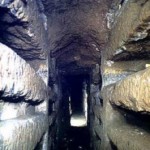 Scientists have found 2 new species of the Kribbella bacterium on the walls of the catacomb of St. Callistus. This is significant not only because, hey, new life forms here, but also because studying the wall-chewing bacteria might help with conservation efforts.
Scientists have found 2 new species of the Kribbella bacterium on the walls of the catacomb of St. Callistus. This is significant not only because, hey, new life forms here, but also because studying the wall-chewing bacteria might help with conservation efforts.
By studying bacteria that ruin monuments, the researchers hope to develop methods of protecting cultural heritage sites such as the catacombs in Rome. The two new bacterial species discovered in the tombs also have the potential to produce molecules that have useful properties, like enzymes and antibiotics.
“The special conditions in the catacombs have allowed unique species to evolve,” said Professor Dr Urzì. “In fact, the two different Kribbella species we discovered were taken from two sites very close to each other; this shows that even small changes in the micro-environment can lead bacteria to evolve separately.”
It’s big news, of course, and potentially great news, but it’s set against the bad news that the catacomb walls are decaying.
Genus and species names need to be italicized. So it’s Kribbella. 🙂
Yessir! Great to see you, btw. :love:
Hola. 😎
This makes me wonder about the bacteria in the Egyptian tombs–isn’t that what may have caused the deaths of several turn-of-the-century archeologists? Besides killing the catacombs, I wonder if it’s dangerous to breathe.
Couldn’t find an email link…so I’ll mention this here. Love the blog and am linking it to my own early history/history of medicine blog. let me know what you think!
Holly
http://www.wonderandmarvels.com
Oo, I love history of medicine! I’m afraid I can’t get to the site right now. Server troubles?
:yes: :yes: 😎 😎 😎 😎 :yes: :yes: :no: :hattip: 😮
😀 :p :chicken: :chicken: :chicken: